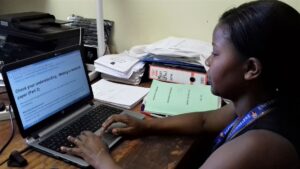
Online learning isn’t a good option if you have a bad internet connection – or is it?
Joanna Wild & Jon Harle – Photo by Muhammad-taha Ibrahim on Unsplash
Two major factors limit the accessibility of online learning in the Global South: firstly an individual’s digital skills, so that they can navigate and study successfully online, and secondly the digital infrastructure that’s available to them, so that they can get online easily and reliably.
Both factors are known to limit participation in online courses and to impact negatively on learning outcomes. But to what extent are digital skills and access to technology the problem?
Read on for more ideas about how to design with connectivity in mind, and join us on 25th April to learn from our expert panel about how to design online courses that mitigate infrastructure constraints.
What is learning design, and why does it matter?
The success of online learning is also known to depend significantly on learning design.
Learning design describes a set of decisions that a team makes as they develop a course: how will participants learn? Which aspects are most important? How much time will they need? What tools will be used? What formats or types of materials will be used to present content? What activities will participants undertake? How will they be guided through the course?
It’s especially important in digital learning, because unlike in face-to-face teaching, it’s much harder for a teacher or facilitator to ‘read’ the learners and adjust their approach ‘on the fly’.
If you have a high-speed internet connection, reliable power supply, and have powerful devices with plenty of memory it’s easy to generate and consume data-hungry multimedia, from downloading large files to streaming videos. If you’re designing a course, you might be easily swayed by technological innovations and impressive design solutions, and end up with a course that requires a lot of data, a stable connection and the latest software or hardware. But that’s going to make your course a lot less accessible to users with older devices, intermittent connections, or where data is expensive.
Putting yourself in the shoes of your learners
When designing an online course, you should do so from the standpoint of a prospective leaner who has the least reliable access to the internet, who gets online at the lowest speeds, who has the lowest level of digital literacy, and who has the least experience of learning online.
That doesn’t mean that you can’t include video content or interactive tools, it just means that you need to create pathways through your content that make it possible for learners to progress and to learn, even if their connections don’t allow them to stream a video or use an interactive tool.
If you embed videos, think about how you can represent the same content in a different way, for example using audio or text. Instead of forcing learners to read or work with a digital resource while they are online, can you provide them with a version they can use offline?
This will help them to reduce their data usage, and enable them to use their available data to take true advantage of what online learning at its best allows – the exchange of ideas with peers from across the globe.
Designing for low-bandwidth and mobile access
INASP’s courses are designed for low‐bandwidth environments. ‘Low‐bandwidth’ is used in a broad sense, not only to refer to low‐speed internet connections, but also connections that have a low or limited internet data allowance.
Our MOOCs in scientific or research writing – which attract the greatest number of learners per course – are designed so that participants can study using their mobile phones. In many low- and middle-income countries, mobile phones are the most common ways of getting online.
An additional benefit is flexibility, since it means learners can follow a course when they’re on the move. The completion rates within our MOOCs are high, between 45% and 50% (it’s hard to get good figures for MOOCs, but rates of around 20% would probably be considered good).
Designing for flexible learning
While they’re important, internet access and power outages are not the biggest challenges for learners who drop out during our courses. Instead time management issues and the pressures of other work are a bigger challenge, cited by 70%. Only 30% mention internet problems and 15% mention electricity problems.
In response, we’ve developed self-paced versions of many of our courses, we extend deadlines where possible, and we keep courses open for a couple of months after their formal conclusion, to allow participants to catch-up or go back over particular sections.
Taking advantage of asynchronous interaction
In the wake of the COVID‐19 pandemic and the ‘emergency remote teaching’ that ensued, may people assume that online courses consist of a set of study materials with a series of live sessions, using tools such as Zoom, Google Meet or Microsoft Teams.
Since 2011, INASP’s courses have followed a largely asynchronous model, where the whole course – including reading and study materials, discussion forums and activities that learners complete – are offered through our Moodle e-learning platform. This allows learners to study when it is convenient to them. We organize live Zoom clinics and embed videos, but these are often optional learning resources, and a transcript is provided for those who might struggle with connectivity.
Join us on 25th April to discuss further
On 25th April, we’ll be picking up these questions with some of our colleagues – Shanali Govender, Centre for Innovation in Teaching and Learning, University of Cape Town, South Africa; Dr Kendi Muchungi, Brain and Mind Institute, Aga Khan University, Kenya; and Professor Dilshani Dissanayake, Research Promotion & Facilitation Centre – Faculty of Medicine, University of Colombo, Sri Lanka.
We’ll be asking them about their experiences of designing and leading online learning programmes in the context of technological constraints.
Watch the recording here: How to design online courses that mitigate infrastructure constraints?
There’s one further webinar in the series on 16th May at 12.00 BST: How can gender-responsive pedagogy inform the design of online courses?
Joining us will be:
- Dr Nicola Pallitt, Centre for Higher Education Research, Teaching and Learning, Rhodes University, South Africa
- Dr Funmilayo Doherty, Yaba College of Technology, Lagos, Nigeria
- Dr Albert Luswata, Uganda Martyrs University, Uganda.
You can read more about these themes and about good learning design in Part 3 of our new book Digital Technology in Capacity Development: Enabling Learning and Supporting Change.

 Previous Post
Previous Post Next Post
Next Post


